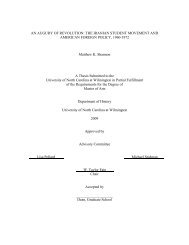HIERARCHAL INDUCTIVE PROCESS MODELING AND ANALYSIS ...
HIERARCHAL INDUCTIVE PROCESS MODELING AND ANALYSIS ...
HIERARCHAL INDUCTIVE PROCESS MODELING AND ANALYSIS ...
Create successful ePaper yourself
Turn your PDF publications into a flip-book with our unique Google optimized e-Paper software.
fitted such as for “conc”, with the “PHA c” referring to the phytoplankton column<br />
of the CIAO data set, or an initial value such as 0 for “growth rate”, indicating<br />
that this particular state variable won’t be fitted to a time-series.<br />
The mention<br />
“system” as opposed to “exogenous” simply states that this variable is dependent<br />
on the system as opposed to being independent like variables such as solar radiation<br />
or water temperature. The full instantiated entity library can be found in Appendix<br />
B and the generic entity library in Appendix C.<br />
For HIPM to be fully functional there needs to be a library of processes. Processes<br />
are the physical, chemical, or biological actions that drive change in dynamic models.<br />
Just as we made a distinction between generic entity and instantiated entity, we<br />
make a distinction between generic processes and instantiated processes. All generic<br />
processes are defined by a name by which entities can tie into the process, the<br />
subprocesses that are tied to that one process and one or multiple equations. The<br />
generic process can also include a set of Bolean conditions that determine if the<br />
process is active, making the process dynamic by turning the process on and off<br />
depending on whether the conditions are satisfied (Borrett et al. 2007). For instance<br />
we could set the photosynthetic process to only occur if a set environment light<br />
variable is greater than zero. We have an example of generic process in Table 2, it is<br />
named “growth”, and any of the following entities “P, N, D, E”can take a role in the<br />
process, then there is a list of the subprocesses, with the entities that can take a role<br />
in the subprocess, that are linked to this process and finally the equation that defined<br />
this process; this equation calls onto the “conc” and “growth rate’ variables that all<br />
entities must have. The instantiated process will take on a specific name and will be<br />
bound to a specific instantiated entity, one of P, N, D or E. The instantiated entity<br />
will take it’s role in the equation of the instantiated process. All the instantiated<br />
processes will be aggregated according to the rule defined in the generic entity. It<br />
is this organization in terms of entity and process that drives inductive process<br />
14
















